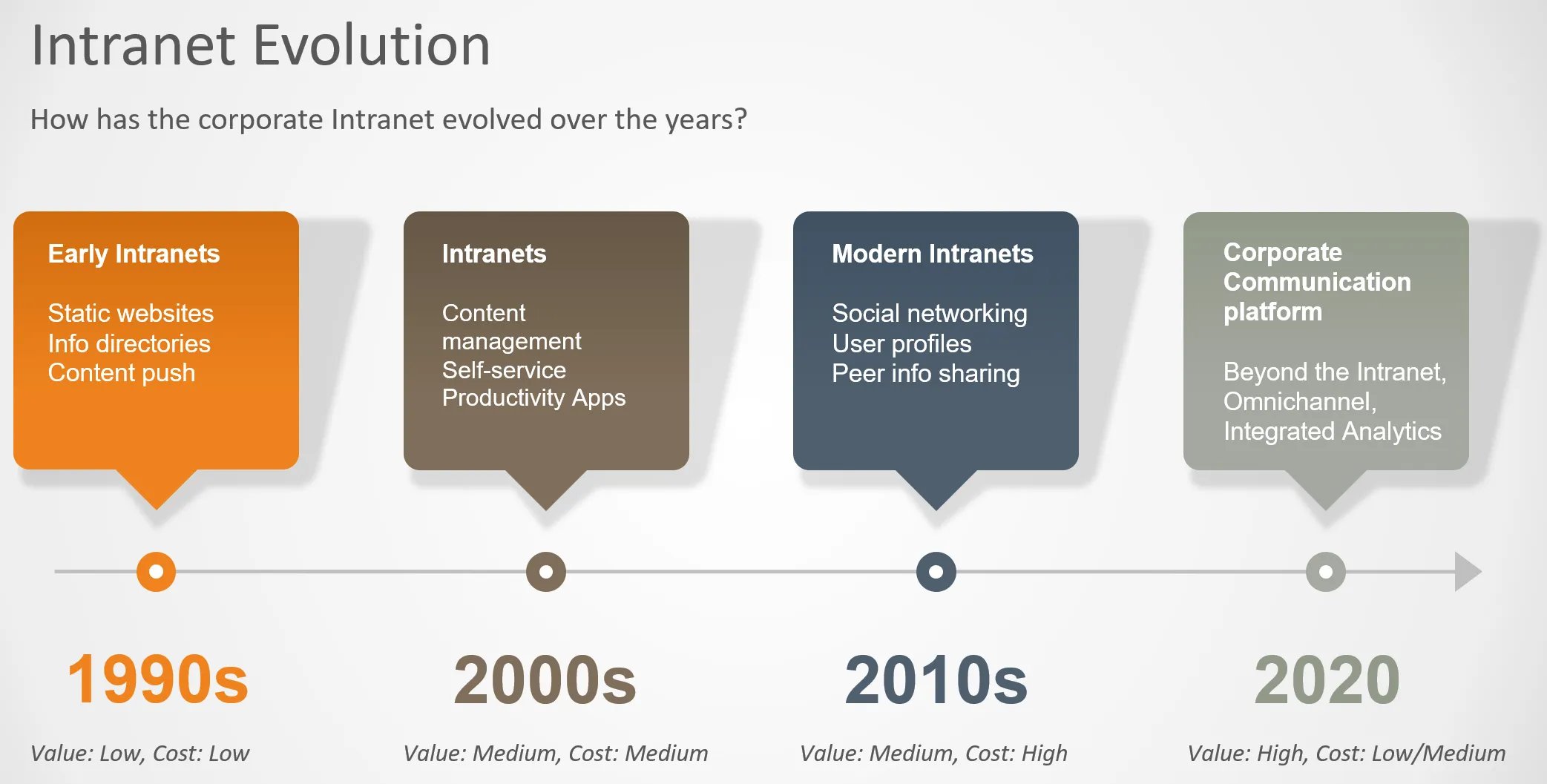Intranets have been around since 1994. Over a quarter of a century later, Intranets initial goals remain true today:
- To increase employees’ productivity through easier access to information including documents.
- To foster more collaboration as well as effective communication.
And they have matured over time. We have a lot of choices for technologies to use for Intranets, from Microsoft SharePoint to hundreds of Software-as-a-Service (SaaS) vendors, all offering a dizzying number of features and varying degrees of customization.

Most organizations are currently on their third or fourth generation Intranet. Each generation added more and more features to entice employees to come back on a regular basis. Each generation was either built in-house, outsourced to a consulting partner, or implemented by a SaaS vendor. And sadly, each generation brought only a temporary bump in engagement, before slumping back to painfully low levels. Usually this was due to complexity in usage, complexity or cost in supporting it, or simply assumptions about how people really preferred to work.
Studies show that on average your Intranet reaches less than 15% of your employees. For example, this study from Prescient Digital Media, even as far back as 2012, showed that only 13 percent of employees said they use their intranets every day. Nearly one third (31%) said they never use it at all. And of that 13%, how many really trust it and value it the way it was intended? Regardless of which way you spin it, it means that 4 out of 5 employees are simply not receiving key communications. Even making it the default landing page when opening a browser doesn’t fix this, as employees tune out or start leaving the browser open with a fresh tab at the ready as a workaround.
When companies realize this, they often turn to one of two strategies, both unfortunately flawed:
- They start planning to overhaul the Intranet. Unfortunately, the next generation Intranet will have the same issues. As the saying goes – doing the same thing and expecting different results is the definition of insanity. The problem is not your current vendor or consulting partner. The problem is that a large majority of employees will never check your Intranet on a regular basis. It just does not fit their workday and standard job workflow.
- They start emailing a newsletter to capture the important information that your employees are missing out on from the Intranet. This generally doubles the effort without doubling the impact. Communicators publish content twice and try to make sense of disparate analytics, if there are any. Executives ask for results, and despite best efforts, the engagement and communication awareness needle barely moves at all. It’s frustrating and heart-breaking, because you are doing everything you can.
The unpopular, but natural question is: Do we really need another Intranet? The answer, and trust me on this, is actually yes BUT it’s not the same type of Intranet. It isn’t the answer to everything, it needs to be focused on what it can do, what people actually use it for, and it needs to fit into a portfolio of channels that are used for reaching people. A portfolio that looks at how are people working and where would they like to get their information from.
You need an omni channel communication platform that allows you to create your content once and automatically publish it across multiple channels including the Intranet, email, Slack, Microsoft Teams, and communication mobile apps. A platform that pulls all of the analytics together and tells you what people are actually reading, and how much, and what’s popular and what’s not. The platform needs to understand the role of a communicator so it can genuinely make your life easier and allow you to focus your energy on where it is most important. A system with proper segmentation and audience targeting will allow you to reach the right set of employees, at the right time, in the right way, and it will tell you how well your efforts are working out. From a new vacation policy or health benefits, to when the all-hands meeting is taking place, to getting feedback on the idea of a leadership retreat, the system should support getting your content seen.
With this type of system in mind, we look at the Intranet differently. Wired into the communication system, it should present relevant information on key pages, knowing who the user is so that they only see what they are supposed to see. We can renovate, instead of completely revamp, the intranet so that it’s more attractive or modern, but we recognize that approximately 15% to 30% of the employees will get their information there. We then look at the other channels to fill the rest of that 70% to 85%, without increasing your level of effort. Create your content once, publish it everywhere. The budget we saved from creating the 5th generation of all department pages or subsites, never mind the hours in meetings we get to avoid, could end up paying for the system.
When looking at different communication channels, the communications platform needs to provide unified analytics. It has to be able to show you where people are going in from, what’s working, what isn’t, etc. The right set of analytics (which we will explain in a future post) will do more than lagging indicators like as surveys or attrition rates ever could. You will know whether people are engaged with the most important information for your organization and will be able to adapt your message, frequency, and channels accordingly. You will have at your fingertips the right reports and analytics to continuously improve your communication efforts.
When we start looking at the Intranet of Old as a set of responsibilities, we come to realize that today different technologies might have quietly taken on some of them. Slack and Microsoft Teams may have taken the collaboration and important files may be getting shared from Box or OneDrive, just to mention two. Also, some complementary channels that were relied on may have now reached the point where they provide a net negative effect, like newsletters triggering the frustration response of “Even more email? Seriously?”
What we need to do is step back and look at the “website where we make policy documents, post communications, and provide search” as being a piece of what constitutes the Intranet of today. And with that in mind, we need to put in place a communications platform that understands that.
We believe that corporate communications is the difference between good and great organizations. Getting it right can be transformative as people are informed and connected and feel like they are genuine part of a greater whole. Communicators should focus on getting the right message, to the right employees, via the channels of their choice, instead of fighting with disconnected systems that leave them frustrated and duplicating effort. An intranet isn’t a “SharePoint thing” anymore (or equivalent), it has changed.
So, do you really need another intranet? Maybe. Maybe all you need to do is renovate it a bit by plugging it into a communication platform that’s got your back because it was designed from the ground up for communicators. And we just happen to know such a thing…

At Sparrow, we believe that focused corporate communications can be transformative. Instead of a collection of broken tools that do not work together, corporate communications should have the same power that your marketing team does. Corporate Communications should be able to reach the right employees, with the right message, on whatever platform they are using, and be able to measure every interaction. We believe that it is time to change the world of corporate communications with a true corporate communications platform that understands what it means to be a communicator.
Book a conversation with us today. “[Sparrow] has proven invaluable…” – Corporate Communications, Hamilton Health Sciences







